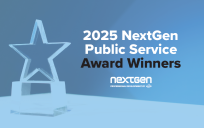Change is inevitable, especially if you work for the federal government. In an industry that faces major changes to the administration and daily operations every 4 to 8 years, it is imperative that government employees and department heads have the practical skills necessary to remain resilient and engaged.
In a recent Agriculture Department (USDA) panel sponsored by Young Government Leaders, “Staying Resilient to Ongoing Change” govies heard from the following federal experts about how they stay resilient in an industry where change is constant:
- Maureen Marks, Veterans Affairs Department (VA)
- Heather McCarren, Veterans Affairs Department (VA)
- Joseph Moore, Defense Department (DOD)
- Brittany Beth, Education Department (ED)
- Nicole Vennell, Health and Human Services, National Cancer Institute (HHS-NCI)
- Rebecca Johnson, Internal Revenue Service (IRS)
If you noticed difficulty adjusting to a change in practices in your agency, you are not alone. Efforts to manage major change within organizations and agencies often fail, not necessarily as a result of poor leadership, but because change, whether incremental or drastic, will affect each employee differently. “Some see change as a marathon and others may adapt quickly depending on skills,” Vennell noted. “The depth of change is highly individualized.”
Marks acknowledged that in the same way that widespread change within an agency will have different effects on individual employees, change implemented across agencies will create different outcomes in each location. “As a result, agencies need some way to assess the activity and see where employees are in the process,” she said.
When assessing employees’ adjustment to change, leaders need to be receptive to differences in coping style and reactions. If a team member or employee reacts negatively to change, they should be listened to, not villainized. “It’s rare that people are a problem, usually they have a problem,” Vennell said. “You have to take the time to hear what their issue is instead of insisting your change is best. Ask how you meet in the middle in a way that will be most effective for the organization.”
A popular sentiment among the panel was that employee engagement is essential to being receptive to change. Even small efforts from leadership to open communication and involve employees in the change process can yield improvement. “Bring people into the fold,” Johnson said. “Don’t just say you’re going to do something within the agency because it’s your good idea. Explain things to people and listen to others. People should be a part of change instead of change happening to them. People will be tolerant and embrace it if they are engaged.”
However, employees may not take it upon themselves to engage in change, especially if they disagree with the modifications to their position or team. “You need the concept of high accountability,” Vennell said. “Employees have to be held accountable for engaging in some way and need to know that there is something they can and should do. Employees can then take positive forward action, which will put them in a better place to navigate the changes.”
While leadership definitely plays a huge part in change management, individuals have to take responsibility for their own resiliency or lack thereof. “During change, you are going through your individual adjustment process,” McCarren said, specifically in reflection of her work for Veteran Affairs.“If you don’t stay active and connected to the mission in the face of change, your actions can negatively affect others. “
Here are a few tactics you can use to remain resilient in the face of change and engage in your agency’s mission:
Connect with your colleagues. “Build a relationship and make connections with people around you to get through change,” Johnson said. To foster these relationships, practice active listening, ask questions and leave space for your team members to share with you so that you are also in a position to help others.
Moore noted that who you choose to connect with is critical to resilience. “If you can find the people who are positive towards change, you will be more successful than if you engaged with people who didn’t want to participate in change.”
Know yourself. In order to engage in change, you will have to recognize and accept your previous barriers to adjusting. “Pay attention to what’s going on inside during a change process so it doesn’t become systemic,” Moore said. “Learn from adversity.” Instead of viewing your previous inability to adapt to change as a negative experience, accept that resilience is a learning process.
Marks suggested creating a career timeline to assess your high and low points of engagement so that you know where you have to improve before change hits. When you are equipped with knowledge and understanding of your shortcomings, you can make positive steps toward progress and engagement.
Put yourself first. We always have some control over how we let change impact us personally. “If you think about how you can influence change and what your role is, you can see a positive impact, “Johnson said. “But if a conflict in core values prevents you from accepting the change, you may have to do something different.”
If you feel that your values and beliefs are being compromised by the changes around the office, Beth advised that you don’t push yourself too far. “Set personal boundaries and prioritize self-care. You will be better prepared to take on the day if you’ve taken care of yourself.”





Rebecca Johnson who is quoted in this article is the highest ranking executive at IRS who is responsible for employee engagement. When I asked her why the IRS does not report out its employee engagement data by racial categories, she replied, “It is not politically savvy.” I guess that is one way to deal with demographic change in the workplace. Deny that it even exists.